
An archive of articles on the silent era of world cinema.
Copyright © 1999-2025 by Carl Bennett and the Silent Era Company.
All Rights Reserved.
|
|
Sacred Fires and Hungry Kisses
The 36th Pordenone Silent Film Festival
| Article Copyright © 2018 by Lokke Heiss. All Rights Reserved. |
We came to cinema as something not yet existent. We came upon no ready-built city . . . We came like bedouins or gold-seekers to a place with unimaginably great possibilities, only a small section of which has even now been developed.
— S.M. Eisenstein, Through Theater to Cinema
We shall not cease from exploration, and the end of all our exploring will be to arrive where we started and know the place for the first time.
— T.S. Eliot
I don’t know Pordenone. I’ve just been through it.
— Ernest Hemingway, Farewell to Arms
| |
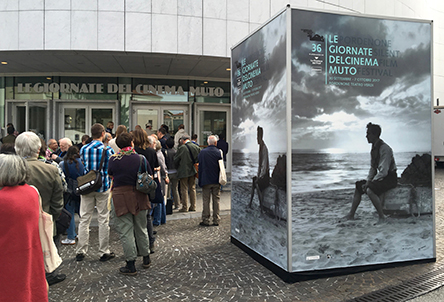 |
| |
Verdi Theater, Pordenone: photograph by Lokke Heiss.
|
Pordenone is a small town an hour north of Venice and those of us who visit it for one week every October don’t really know the town, nor do we truly know what we expect to find there . . . and afterward none of us can say for sure what we have seen, because there’s always too much to see.
But it doesn’t stop us from trying. I’m talking about the annual pilgrimage to the Pordenone Silent Film festival, and this year, the silent film festival featured stories that were as diverse as the world in which we live – with the miracle of film we found ourselves one moment standing on a cragged and lonely mountain in Norway, in the next moment jostling with the teaming masses of New York City. One second we were watching the loneliness of heartbreak and lost dreams on a small Japanese island, and the next second we were shooting six-guns and racing for our lives alongside a steam locomotive. In other words, this must be the 2017 edition of the Pordenone Silent Film Festival.
Opening Night: The Crowd Beckons
| |
 |
| |
John Murray and Eleanor Boardman in The Crowd (1928).
Photograph: Silent Era image collection.
|
Everyone has their own choice for the best silent film ever made, my choice is King Vidor’s The Crowd (1928), which screened on opening night with a live orchestral score by Carl Davis, who was present to conduct his own music.
The premise of The Crowd is simple: It’s the story of a man named John Sims, born on the Fourth of July, 1900. Twelve years later, John’s father dies but not before he has drilled into his son the need for him to be better than everybody else — to be important, to stand out from the crowd. At the age of 21, John sets out for New York City, gets a job at an insurance company, then meets and falls in love with a woman, Mary (Eleanor Boardman). They marry and raise a family. John has the normal strengths and failings we all have but one thing he has an extra helping of (courtesy of his dad) is ambition. As life’s disappointments mount, he nurses his ambition and pride as best he can, burying it deep inside of himself. Worse, he feels ashamed that he’s just one of ‘the mob’ and this isolates him from his wife and children. And when tragedy strikes the family, John’s pride comes roaring back, this time wrapped in the disguise of feeling sorry for himself — John loses his job and becomes a vagrant. Mary, long loyal to her husband, is persuaded to end the marriage. John’s despair becomes so great he is at the point of ending his life.
It’s at this moment that his son, who is tagging along with him in the street, tells him what a great dad he is. Recognizing he has his son’s whole-hearted love and support (something he never had from his own father), John becomes aware he has received a secular kind of blessing, an affirmation of his self-worth. As Ralph Waldo Emerson would describe it, “Belief consists in accepting the affirmations of the soul; unbelief, in denying them.” John realizes that the love between him and his son is greater than any trauma or tragedy from his past, and his pride — which was nothing in the end but fear of failure — falls away, and with this he is able to reclaim the love that his family is waiting to give him.
The Crowd is immeasurably helped by the performance of the two leads. John Murray, chosen because the role called for an actor with virtually no artifice, gives one of the greatest of all performances in silent film. Eleanor Boardman, whose prior films typically cast her as a sophisticate, beautifully portrays a simple woman progressively worn down by life, but still doing everything possible to keep her family together. For its use of technical aspects: use of moving camera, forced perspective, lighting, and for its understanding of story structure and thematic content — for its ability to use — with ease and facility — every effect, every technique at that point understood and learned by filmmakers to tell a story, The Crowd stands as the summation of the art of film in 1928, the year it was released.
The Crowd also strikes new ground in what would later be called modernism. With its interest in the emotional lives of its characters rather than with plot and, with its fragmentary assemblage of a typical life of an ordinary family, the film invites comparisons to other modernist works by writers such as James Joyce and Virginia Woolf. The Crowd even manages to be subversive. Vidor’s inclusion of a toilet in the scene of their cramped apartment is as shocking in its own way as Henry Miller’s use of ‘unprintable words’ in Tropic of Cancer. Louis B. Mayer famously hated the film because of the bathroom scene — he called it that “damn toilet film.”
These subversive qualities had their repercussions; the studio, not knowing what they had, delayed the release of this film and with this delay (which coincided with the public’s sudden interest in talking pictures), and with the studio’s lack of support, The Crowd failed to gain the sweeping recognition that it might otherwise have achieved. Although critically acclaimed, The Crowd is often brushed aside when talking about important films of its era. Having no major stars and with no easy way to describe or sell the film, The Crowd has an odd ‘orphan’ status among the films of its era — outside of festivals or film school, few people have seen it, at least on a big screen.
| |
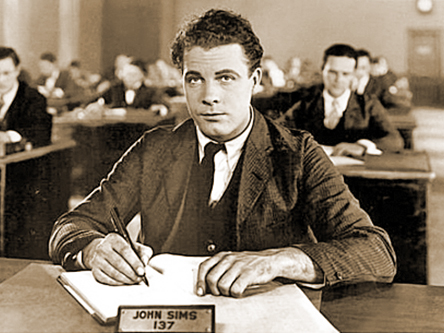 |
| |
John Murray in The Crowd (1928).
Photograph: Silent Era image collection.
|
Because of this history, The Crowd is perhaps more important in its influence on future filmmakers. The Italian directors saw in King Vidor’s work a populist vision of the common man, the template of their vision of neorealism. Vittorio De Sica himself described The Crowd as the first ‘neorealist film,’ and freely admitted he used elements of this film for Bicycle Thieves and Umberto D. Roberto Rossellini is quoted as describing the ‘unforgettable impression’ of The Crowd made on him, stating that watching the film “really struck me and put me on the road toward truth, toward reality.” And who can forget Billy Wilder’s rethinking of many ideas from this film, when he made arguably his best picture, The Apartment, even playing direct homage to the film by recreating The Crowd’s opening scene of the New York skyline panning into a dissolve of endless desks manned by robotic workers?
And yet there is more to The Crowd than merely a summation of its artistic achievements or its importance in shaping the future of filmmaking. When John learns to accept his limitations that he is just an ‘ordinary man’ (even to rejoice in this realization — because with this insight he acquires a particular kind of freedom), The Crowd is offering an update of Walt Whitman’s Leaves of Grass, which also celebrated the freedom of the ordinary man. To conclude you are ‘nothing special,’ to accept your fate as one of the many blades of grass in a field stirred by the wind, is to see the world with new eyes.
In his essay ‘Inside The Whale,’ George Orwell describes Whitman’s insight that by acceptance of our ordinariness, there is a new-found joy of discovery — despite all hard knocks, the disappointments, all the pettiness of life, one can still find “that he is enjoying himself . . . Whitman was writing in a time of unexampled prosperity, but more than that, he was writing in a country where freedom was something more than a word.” Orwell however, offers a cautionary conclusion, “Luckily for his beliefs, perhaps, he died too early to see the deterioration of American life that came with the large-scale industry and the exploiting of immigrant labor.” The Crowd is offering a current appraisal of the boundless optimism of the American Dream as envisioned by Whitman: Yes, the freedom to pursue your dreams is still part of our nation’s founding principle, but that dream is bounded by many barriers, both visible and invisible, and perhaps for most of us, the important part of living each day will be the ability to appreciate the small, simple things in our daily life, such as the gratitudes and affirmations we get from friends and family.
As I walked out of the theater, I saw Kevin Brownlow and confessed to him that this was my choice for Best Silent of All. He smiled, and said: ‘Mine too.’ That made my night.
Films from Sweden: The Challenge Answered
The Golden Age of Swedish film is usually bookmarked from the premier of Victor Sjöström’s adaptation of Henrik Ibsen’s Terje Vigen [A Man There Was] (1917), up to 1924, where many of the Swedish stars and directors were lured to Hollywood. Of the numerous excellent directors working in Sweden in this time period, two names stood above the rest: Victor Sjöström and Mauritz Stiller. Together, these men produced a series of films that rank among the best of all silent cinema. But there were many other talented directors and filmmakers in Sweden whose name did not start with the letter ‘S’ and their efforts have often been overlooked. This year’s program highlighted films from these other directors, and also films made in a conscious effort to shape what would now be called ‘Nationalist Cinema,’ that is, prestige, large budgeted films using sources considered important to a country’s literature and culture.
One my favorite films of this program is Gypsy-Anne, directed by Rasmus Breistein (1920). Although made by Swedish filmmakers and actors, it’s the first Scandinavian feature film set in a distinctly Norwegian setting, and the first major film adapted from a well-known literary work, “Fante-Anne,” written in 1868 by Kristofer Janson, a writer best known today for chronicling the effects of the massive immigration from Norway to the United States in the latter part of the 19th century.
Janson used the genre of what were called “peasant tales” to tell the story of a smart but quick-tempered orphan, Anne, who is raised in an affluent farmstead in the Norwegian countryside. Anne becomes childhood friends with Aldor, who is the son and heir to the farm, and all goes well for a few years, but when they become older and fall in love, Aldor’s stern mother forbids the marriage and sends Anne away from the house to live with the servants. Jon, a farmhand who has faithfully worked for the family, has adored Anne for many years, but when he shyly tells her of his love, she rebukes him, since she feels Aldor is clearly the man for her.
But Anne is in for a bitter disappointment, as class and social distinctions pull Aldor away from her influence and into the arms of another young woman, one more socially suitable for Aldor’s parents and their place in the community. Worse, Anne is soon stunned to find out that not only has Aldor jilted her, but that he has been helping build a new house that he will live in with his new bride. With this blow to her pride and vanity, Anne plots revenge and sets fire to the new house. As the flames rage and the smoke climbs high into the sky, Anne realizes what a terrible mistake she has made, and then to make matters worse, Jon finds her coming from the burning house, so he knows she has committed the arson. For the first time in her life, Anne is forced to consider who and what is truly important to her; meanwhile her friends are forced to make the same decisions. Gypsy-Anne is a deeply affecting film that explores complex psychological truths about romance, passion, and sacrifice, but above all else, it’s film about self-discovery — it’s about how a woman is able to shake off the fate decreed to her by custom and society, and then strike out for a new life in another land.
| |
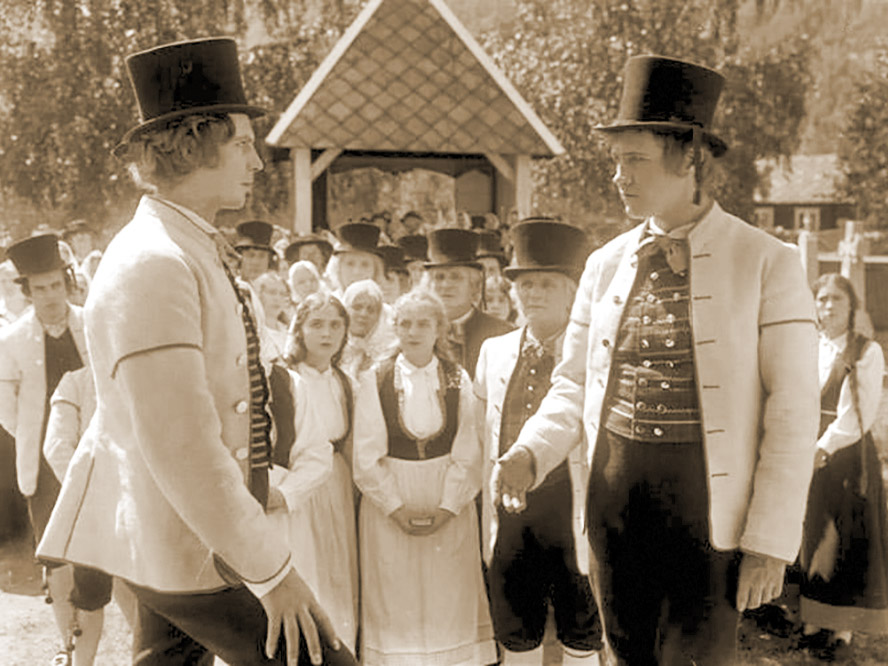 |
| |
Lars Hanson (left) in Synnöve Solbakken (1919).
Photograph: Silent Era image collection.
|
Another wonderful film from this series is Synnöve Solbakken [A Norway Lass] (1919). Adapted from a story by Bjørnstjerne Bjørnson and directed by John W. Brunius, A Norway Lass is about the lives of two farming families that live next to each other near a small village in Norway. Growing up together as children Thorbjörn (Lars Hanson), and Synnöve (Karin Molander) share a deep affection for each other, but Thorbjörn has a temper, which concerns Synnöve’s parents. During a festival, a devilish farmhand Aslak (Einar Rød) happens onto the scene, and looking to incite trouble, goads Thorbjörn into fighting a rival who is also in love with Synnöve. In the fight, Thorbjörn is almost killed when his opponent — in cowardly fashion — stabs him with a knife. While Thorbjörn slowly recuperates from his almost fatal wound, the question lingers for the whole community: Will Thorbjörn be able to forgive someone who tried to kill him, or will he revert to his old ways, and look for revenge? The fate of Thorbjörn’s standing in the community and his possible marriage to Synnöve hangs in the balance. Even though this film was directed by a Swede and has Swedish actors in the major parts, as a Norwegian American myself, A Norway Lass feels incredibly ‘Norwegian’ to me — in the emphasis on the social cohesion of the community overruling individual passions, to the folk dance sequences, even to the presence of trolls and fairies — that if not physically present, lurk in the background of people’s minds.
Not lurking in any way, but standing out in the clear sunlight is the charismatic Lars Hanson as the lead. Some people called Hanson the ‘Swedish Gary Cooper’ but I prefer to think of Gary Cooper as the ‘American Lars Hanson.’ Whichever label you choose to label Hanson, this is a great role for him and it plays to his ‘tough guy, man of action’ image. Karin Molander is also excellent as Synnöve and demonstrates her range, since she is more famous for her roles in Swedish comedies. The connections of this ‘farm melodrama’ to the American Western are clear – I would go so far to say that A Norway Lass is a Western without guns. And with its celebration of the land and the people who till it, A Norway Lass also has an interesting affinity to the musical Oklahoma. There are a lot of other fascinating elements to this film, including a series of tableaux vivants simulating famous paintings, such as a scene that duplicates Adolph Tidemand’s painting “Low Church Devotion”, which depicts a community church meeting. For those of you familiar with F.W. Murnau’s use of paintings as visual references in his films, it’s eye-opening to see that this idea was already in full play by 1919.
One last point: There’s a saying in Hollywood that if you want to pick one film genre that always works, choose a ‘traveling angel story,’ where an angel (or someone like an angel) comes into a difficult situation and helps solve everybody’s problems. This device is used in movies as diverse as Frank Capra’s It's a Wonderful Life to Henry Koster’s The Bishop’s Wife, starring Cary Grant and Loretta Young. A version of the ‘traveling angel story’ is the ‘traveling devil story’ — that is, a devil or devilish person comes in and creates problems that people then have to solve, thus better understanding themselves. A Norway Lass uses the ‘traveling devil’ device to great effect, as Aslak’s diabolical machinations force Thorbjörn to confront his own temper, all the while adding another layer to the supernatural elements of trolls and goblins already bubbling up just under the surface of this very Norwegian tale.
| |
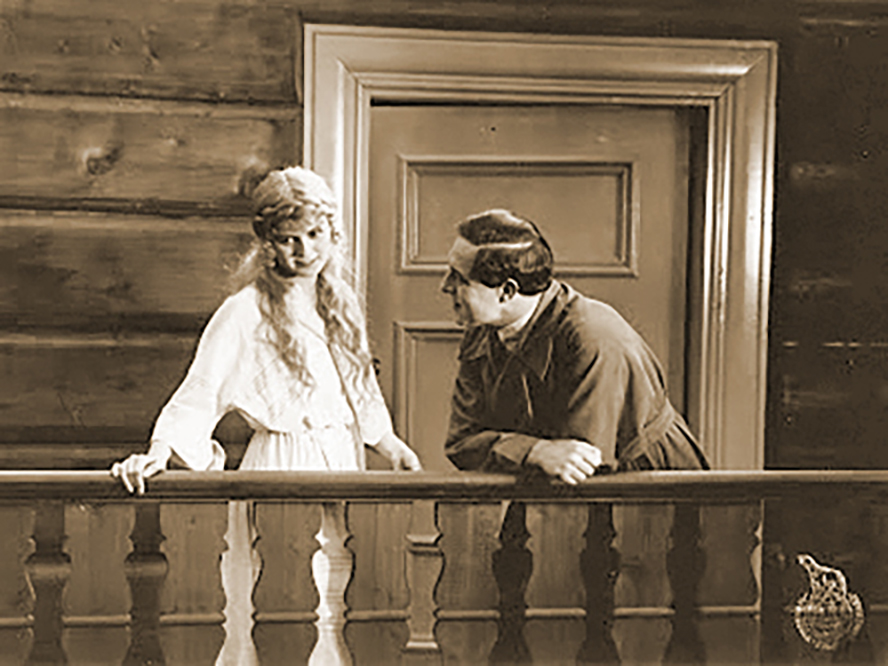 |
| |
Karina Bell and Emanuel Gregers in Morænen (1924).
Photograph: Silent Era image collection.
|
While the other films in this series went out of their way to show beautiful hills and picturesque valleys, Morænen [The House of Shadows] (1924) goes instead for a dark and desolate landscape that matches the story it plans to tell. Thor Brekanæs, a powerful lord of large estate in northern Norway, discovers that his son Vasil is not his, as his wife had an affair with another man. She is presently pregnant with a second child (who is his son), and as soon as this baby is born, in a rage, he throws his wife out of his house and tells her to kill herself, which in deep shame, she does.
Twenty-five years later, Thor Brekanæs is still enraged over his wife’s infidelity (Norwegians can really carry a grudge!). Meanwhile, the second son is an imbecile, barely able to take care of himself, and is being raised by Brekanæs’s young god-daughter Thora. Brekanæs wants Thora to marry Swein, the son of a local farmer who is primed to take over the estate. Meanwhile, Vasil returns from his law studies — always attracted to Thora, when he sees that Brekanaes plans to marry her off to Swein, Vasil steps in, forbidding the marriage. Brekanæs is violently angry at his bastard son thwarting his plans, but at this point he is killed, with all suspicion pointing to Vasil as the assailant. As the murder charge is being prepared, a surprise witness is called, someone who can explain all that happened, forcing everyone to rethink the entire situation.
The plot of this film has more than a little familiarity to John Steinbeck’s “Of Mice and Men,” (which was first published 13 years later, in 1937), but The House of Shadows has by contrast a dark and brooding Nordic sensibility, which it uses to serve up a smorgasbord of spiritual decay, family secrets and deeply repressed desires. If you like High Gothic served Scandinavian style, this is your film.
| |
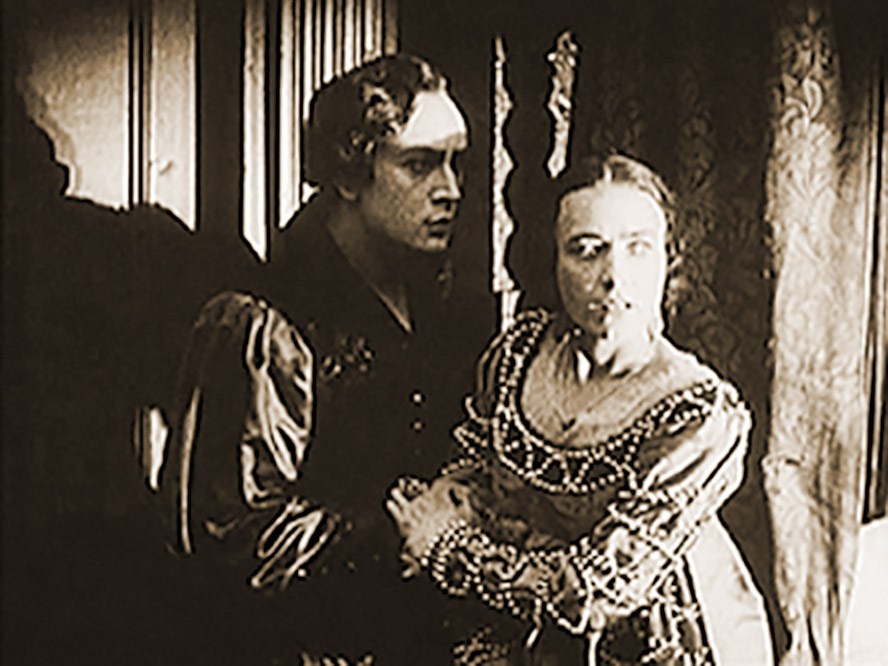 |
| |
Gösta Ekman and Jenny Hasselqvist in Vem dömer? (1922).
Photograph: Silent Era image collection.
|
No program of Swedish films from the Golden Age would be complete without at least a nod to one of the masters, and the festival obliged by showing Victor Sjöström’s little known Vem dömer? [Love’s Crucible] (1922). One reason Sjöström’s movies are so captivating is that he often adds an extra level – often a spiritual or metaphysical one – to whatever story he was telling, and that was certainly true with this film.
In Love’s Crucible, Ursula, a wife long abused by her husband (also played by Sjöström) puts poison in his drink, but before he can drink it, he collapses and dies of a weak heart. She is accused of murder, and is given a trial by fire (she has to walk across a flaming pyre) to prove her innocence. Her priest says that we are guilty of acts, not thoughts, and with this knowledge, she is put in an agonizing dilemma: The only way she can survive her trial by fire is to ask and have received forgiveness for her sins, but how can she sincerely ask for forgiveness for a crime she didn’t commit? Or did she?
With this setup, Sjöström has placed a delicious murder mystery nested inside a larger story, a mystery that has a Schrödinger’s cat-like quality to it, because she must solve this mystery of why she’s guilty, or she will die herself. Love’s Crucible is a great (if mostly unheralded) film and adds to my opinion that film-for-film, taking as a whole his entire body of work, Sjöström is the world’s greatest silent film director.
The Canon Revisited
Each year the festival explores films that are so familiar, or so much part of the current repertoire, that they have never been shown in Pordenone. This year, two of these films were Ménilmontant and Warning Shadows.
| |
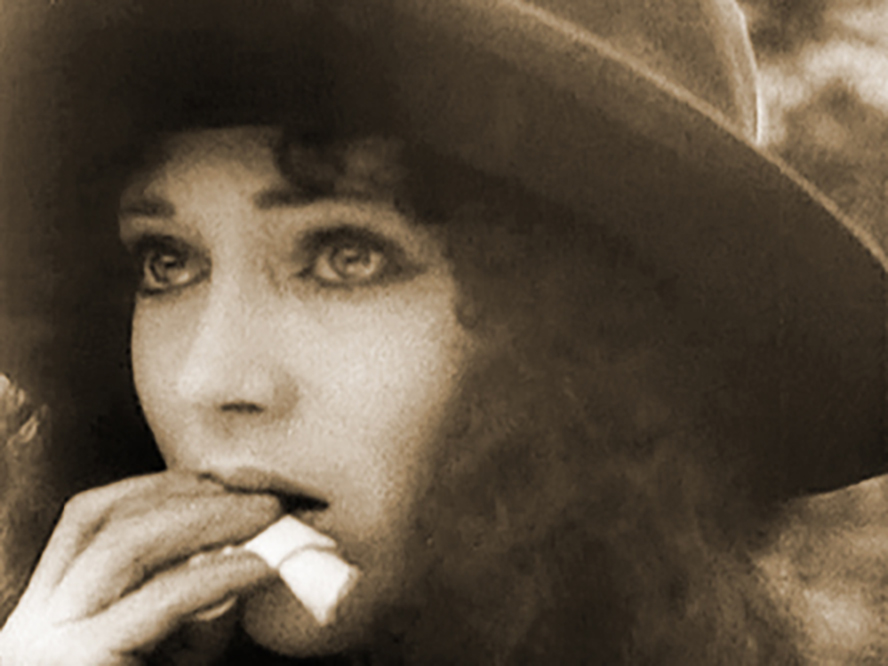 |
| |
Nadia Sibirskaïa in Ménilmontant (1926).
Frame enlargement: Silent Era image collection.
|
The director who made Ménilmontant (1926), Markus David Kaplan, was born in Estonia, and fled to France after his father was murdered by the Bolsheviks in 1919. As it was the fashion of artists and filmmakers in that era to rename themselves to honor important locations or characters, Kaplan adopted the name Dimitri Kirsanoff, in homage to a character in Turgenev’s “Fathers and Sons.” While playing cello in the orchestras of cinema theaters, he met Geneviève Lebas, a Frenchwoman from Breton who had come to Paris to look for work as an actress. They became both a couple and a team, and following his example, she renamed herself Nadia Sibirskaia. Together these ‘fake Russians,’ along with their friends, set forth to make a film about a pair of orphans who have to make it in the big city.
Ménilmontant over the years has gained many admirers, such as critic Pauline Kael, who called it “an exquisite, poetic 40-minute movie that is one of the least-known masterpieces of the screen.” Lots of us agree with her, and today Ménilmontant is considered of one of the greatest of all impressionist films from the silent period. The plot of the film follows the lives of two young sisters after the violent slaying of their mother by their deranged father. Suddenly orphans, they have only themselves for comfort, and as they grow up, the girls find themselves poor and hungry in a seedy and rundown section of Paris, Ménilmontant. A young Frenchman (Guy Belmont) starts to date the younger of the sisters (Nadia Sibirskaia), and thinking he is sincere, she sleeps with him, to find he is a roué and scoundrel who abandons her at the first opportunity. Now pregnant, and no money for food she is reduced to abject poverty. But is her older sister faring any better? Will the two sisters get back together?
While this entire film is fascinating for its narrative compression and multiple ellipses, it’s perhaps even more memorable for the few moments when it chooses to slow down the action. The most famous of these occurs when the younger sister, not only starving but now with a child, sits on a park bench next to a stranger, who kindly gives her scraps from his sandwich. The moment is eye-watering and heartbreaking to watch, but is also mesmerizing because of the exquisite beauty of Nadia Sibirskaia in the lead role. If there was ever an example of the power of a silent film to generate powerful emotions — to move or sway an audience in a way that a talkie film can only dream of approximating, I would nominate this scene from Ménilmontant.
As brilliant as portions of this film are, success for this pair would be fleeting. The coming of the sound period in France saw an industry consolidating its resources, leaving many avant-garde filmmakers scrambling for work. Kiranoff and Sibirskaia would go on to make several more films together, but Kirsanoff had difficulty adjusting to the new aesthetic of talking pictures. Sibirskaia had better luck, with good acting roles through the 1930s with such directors as Jean Renoir, but neither of them were able to equal their work together in the late silent era. Still, their films together will serve as a benchmark of what silent cinema can do so much better than talkies, which is to speak the language of the heart and not the mind.
A film firmly lodged in the canon, albeit more for academic reasons than popular status, is Schatten — Eine nächtliche Halluzination [Warning Shadows] (1923) directed by German-American Arthur Robison. When asked to name a film that most describes all aspects of German Expressionism, other than The Cabinet of Dr. Caligari, it’s hard to think of a film that ‘checks off more boxes’ than Warning Shadows does. The story, which takes place in the late 19th century, involves a wealthy baron who invites a number of guests over for dinner. The baron, described in the film as the Man (Fritz Kortner) and his wife, Woman (Ruth Weyher), have invited a number of bachelors, all of whom begin to flirt his wife, and most prominent among these guests is a man named Youth (Gustav von Wangenheim, who played Hutter in Nosferatu). At this point the party finds itself with a surprise guest, a Puppeteer (Alexander Granach, who was Knock in Nosferatu). After sizing up the situation, for a fee the Puppeteer offers to give a show, using shadow puppets as the main event. The intrigued party guests sit down to the dinner table to watch, and find themselves hypnotized by what they see — soon the shadows on the wall take on the personae of everyone in the manor, and play out their fantasies and desires.
The conflict escalates among the wife, husband and guests until there is at last fight and then a murder . . . and then the hallucination dissipates and everyone wakes to find it was all a dream. The guests of the dinner party leave, chastened — at least temporarily — and the puppeteer rides off on a pig, looking for his next performance.
Warning Shadows is an easier film to admire than to like, its chief liability being that the film is so committed to its expressionist doctrine of types rather than well-rounded characters that it can be hard in the film to find someone to care about. For example, when one learns the names of the lead roles are: Man, Woman, and Lover, it’s clear where what direction the story will take.
But there are many other reasons to watch Warning Shadows, for example, this is a great movie to watch on a big screen as the photography (by Fritz Arno Wagner) and production design are first rate. In fact, there are so many people in this film that also worked on Nosferatu (including Albin Grau, who is one of the film’s producers), that it’s hard not to think of this film as an ersatz sequel to the Murnau film released the year before. When Gustav von Wangenheim comes sauntering into the manor house, looking very much unchanged from when we saw him in Nosferatu, it’s easy to go with the idea that this is the same character as Hutter, and we we are taking up his story after the death of his wife a year before. Hutter is back, with a new attitude, a new tailor, and a very new libido.
Also Warning Shadows is yet one more film in this festival that falls under the category of a ‘traveling devil film,’ where a devil, trickster, imp, or a similar being comes into a community to stir things up. To emphasize the point, in last scene, we have the impression he is off riding his pig to some other troubled house where he can offer more of his unusual services.
Late Japanese Silents
When you get a silent-film crowd together and give them enough beer, at some point a certain question — it’s more like a plea — will always come up. I call it the ‘three-year lament,’ and it goes: “If only it had taken a few years (the exact number ranges from one year to never, but three years is often a consensus) longer to perfect the technology for synchronized dialogue, just think how many more silent film masterpieces we’d have to enjoy?” Seeing how many great films were made just at the end of the silent era, I think there is something to this argument, and a partial answer to this ‘three-year lament’ can be seen with Japanese cinema. Because Japan converted to sound years later than most other industrial countries, their era of silent cinema extends all the way to the mid-thirties. The advantage of this delay gives silent film enthusiasts the opportunity of having an extended ‘overtime’ in which the national cinema of Japan still belonged to the silent era. Unfortunately, because of wars and national disasters, the vast legacy of early Japanese cinema is missing, so in a way, it’s even more important that the sound era was delayed if only because the vast majority of silent Japanese cinema we do have is from this time period.
| |
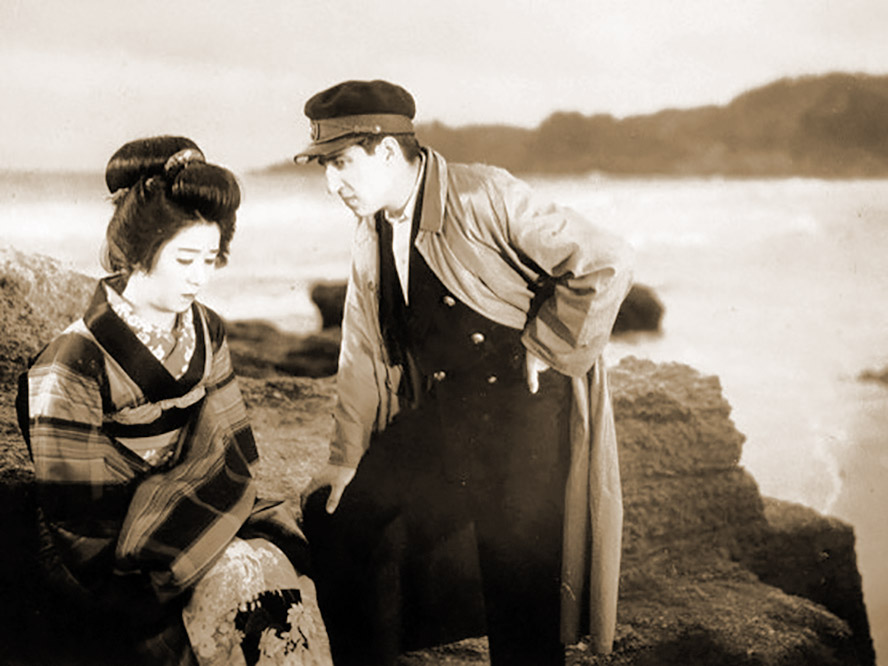 |
| |
Yoshiko Tsubouchi and Ryoichi Takeuchi in Shima No Musume (1933).
Photograph: Silent Era image collection.
|
This year’s program screened two of these ‘late silents’, the first being Shima No Musume [The Island Girl] (1933), directed by Hotei Nomura (the father of ‘thriller director’ Yoshitaro Nomura). Both the film and its director were unknown to me before this week, but it ended up as of my favorites of the festival. It's the story of Okinu (Yoshiko Tsubouchi), a poor girl on a small Japanese island, who becomes involved in the lives of two men: a sailor Ureo (Kazuo Tsukiyama), and a student from Tokyo, Ryoichi (Hideto Ogawa). The dramatic impact the men’s lives have on her is told in a manner which pulls in the complications of gender and class that are so much a part of Japanese society, the acting and script for this film are superb, the direction subtle and effective. Judging at least from this one film, as a director, Hotei Nomura reminds me of Ozu, except with more of an interest in melodrama — in other words, this film reminded me of Ozu with a generous touch of Sirk . . . and if that description piques your interest, I’ll add that Hotei Nomura has a total of 72 films to his credit — if any more of his films exist and are as good as Island Girl, they figure to be a goldmine for those who love Japanese film.
Better known than The Island Girl is Yasujirô Ozu’s Tokyo no yado [An Inn in Tokyo] (1935). As discussed, the silent era in Japan lasted all the way to about 1936, and this is Ozu’s last silent film, shot in 1935. The story is about a man Kihachi (Takeshi Sakamoto) and his two young sons, Zenko (Tokkan Kozo) and Masako (Takayuki Suematsu), who scrounge around the industrial suburbs of Tokyo looking for work. This film has been hailed as one of the first Neorealist films and I agree with that assessment; the first half of the film is similar to Bicycle Thieves in that it explores difficulty of a being a good father when met with the horrors of poverty and hunger. The themes of this film prefigure De Sica, but the landscape is right out of Antonioni, with the father and his sons wandering among water towers and factories that appear more as abstract forms, rather than real buildings — it’s clear this family is trying to survive in the most alienating conditions.
Just when you think a missing bicycle is going to turn up, Ozu opens up the story to include a mother and her daughter who are also homeless, and their plight becomes part of a dilemma of who-gets-what resources. Ultimately, An Inn in Tokyo asks a central question of humanity that we all must face: What is a family? Is it people related by blood? Is it a group of people held together by a common belief or goal? Or is it something more mysterious? Ozu spent much of his career trying to answer this question, and this film is a key milestone of this lifelong interrogation of this question.
Short Subjects and other Quick Takes
Other films of the week that deserve mention include a Leo McCarey comedy featuring Max Davidson, Don’t Tell Everything (1927), where Davidson courts a rich widow, but is afraid that if she learns about his good-for-nothing son (Spec O’Donnell), she may call everything off. Max Davidson is the star of this Hal Roach comedy, but it’s really Spec’s film to shine in, and shine he does, especially when he is forced to play a girl, and the antics and visual spectacle of Spec O’Donnell in drag make this one of funniest of all of Max Davidson’s shorts.
Jeanne Eagels was one of the most famous actresses of her day, but was in only a few films — one of which is The World and the Woman (1916). It stars Eagels as Mary, a ‘woman of the streets’ who seeks refuge with a Christian family in the Adirondacks. Once there, she finds God, and becomes a faith healer. Displaying a considerable talent in healing the sick, Mary has a supreme test of faith when she has trouble healing a paralyzed girl, but in the end, the girl’s health and her faith are both restored. This all sounds as schmaltzy as a film can be, but with the great talent of Miss Eagels, she makes the artless into art by projecting a guileless performance so sincere that you’ll soon be in the aisles cheering her on with the rest of us. By comparing this film to her early talkie picture The Letter, one can see the huge range this actress had when she was at her peak.
Midweek in the festival, the evening line to get inside the Verdi Theater was much longer than usual — the reason for such a long line soon became obvious. Everybody, even casual film fans, were jostling for a seat because this was Louise Brooks Night. Tonight we would see the recovered segment from Now We’re in the Air (1927), the buddy picture starring Wallace Beery and Raymond Hatton, which featured Louise Brooks in a dual-role as twins, one raised German, the other French. While waiting in line, I thought of the obvious opening sentence for this review: Brooks Before She Was Brooks. Then I would talk about her career in Hollywood films, and how she left for Germany for stardom, and eventual iconic status.
But after watching her in this brief 23 minutes, I threw this entire idea away. In just the brief moments Louise Brooks has in this surviving footage, she commands all one’s attention — whatever ‘it’ was, she already had plenty of it, long before she left for Europe. These few minutes are tantalizingly short, but a huge find for any real Brooks fan.
Another pleasant surprise was The Deadlier Sex (1920), starring Blanche Sweet and Mahlon Hamilton, and featuring a large part for a young Boris Karloff, who plays a French Canadian trapper. The story starts with Mary (Sweet), who takes over her late father’s business interests, but becomes so concerned about the rigid, uncaring, and hard-headed practices of her late father’s business manager, Harvey (Hamilton) that she has him kidnapped and taken to the forest wilderness to teach him a lesson. Harvey first thinks he has been the victim of some kind of blackmail or robbery, but gradually begins to understand Mary has his best interests in mind and softens to her. Meanwhile a French Trapper (Karloff) has been employed by Mary to keep Harvey from escaping down the river and, after he falls for her, Mary finds her scheme has become way more complicated than she bargained for.
The chief pleasure of this unusual comedy is the prominent role of Karloff as the French Trapper. Karloff was 33 when he made this film, and when he gets into a shirtless knock-down, drag-out fistfight with Mahlon Hamilton, he looks both young and buff — move over, William Holden! Seeing a youthful and virile Boris Karloff is not something many of us have ever contemplated, but Holden fans, have no fear. As the story shifts to a wild river near the Canadian border, many miles from any town. Blanche Sweet seeing Karloff put into the bank with his canoe, asks him if he’d like to do something for her, and offers him more money than anyone would normally offer to a total stranger. Karloff is surprised at the amount, then gives a familiar, sinister smile and asks, “Who do you want me to kill?”
Don’t worry. Karloff is still Karloff.
Sometimes the best part of this festival is when you get completely surprised by what you see on the screen. This is what happened with the screening of Dawn (1928), directed by Herbert Wilcox. The film is a biopic about British nurse Edith Cavell, who became part of the underground network to rescue allied soldiers in WWI and get them back to England. The story is fascinating in its own right, but what makes the movie so wonderful to watch is the command performance of Agnes Sybil Thorndike (1882-1976). I didn’t know Thorndike’s reputation, but in her very scene, her gravitas is so magnetic that I knew I was in for something special. But I didn’t know how special she was until later, when I read about her career, about how she was so esteemed an actress that George Bernard Shaw wrote Saint Joan especially with her in mind, and that her ashes are now in Westminster Abbey. Dawn is a compelling film about a courageous woman in a time of war, perfectly cast by one of England’s finest actresses.
The Rin Tin Tin Award for 2017
One of the oddest films screened this week was Nel Paese dell’Oro [In the Gold Country] (1914) shot in Italy but set in Mexico. The first part of the story takes place in the rugged hills where a gold-mine owner, Gallegos, has become rich. One of the local cowboys, Alonzo is in love with Gallegos’s daughter, Matilde, who rebuffs his advances, preferring a new arrival, Giovanni Fargas. Angry at his rejection, Alonzo is convinced by his friends Fedro and José to attack the Gallegos estate; they surround Gallegos’s house and set fire to it, then kidnap Matilde, killing her father in the process. Giovanni, with the help of his dog Toby, rescues Matilde and leads her to safety.
The story now jumps forward several years, Giovanni and Matilde, now married, have a son and are happily living in Vera Cruz. Unfortunately when visiting a zoo, they are recognized by Fedro and José, who are now zookeepers. Plotting revenge, the two men carry out a second kidnapping, this time taking their son. What the two kidnappers have not counted on is Toby, who follows the two men out of the window, trails the horse and carriage taking the men and boy away, tracks the men down a culvert that opens from the street to river bank, and then tails the two men, now on bicycles, to an area outside town.
If you think that’s impressive enough, Toby is just getting started. While running after the two men pedaling furiously on their bikes, the dog closes the distance and manages to distract one of the kidnappers to such a degree that he sends his bike over a cliff, falling to his death, Toby then hounds the other bicyclist (carrying the boy) to the point that he loses control, sailing his bike off of an embankment and into a river. Jumping into the water, Toby harries the kidnapper until he weakens and drowns, then moving his attention to his ward, pulls the boy onto dry land. The last scene of the film shows a very wet Toby somehow managing to drag or somehow bring the boy miles back to his parent’s house, where they are received by an incredibly grateful pair of parents.
In giving this award, Rin Tin Tin adds his reservations about the feat: Yes, it’s impressive to single-handedly rescue a boy from two kidnappers. But to drown one and knock the other off a cliff? One must use cleverness instead of violence, a dog should never descend to thinking like his master. Still, such a display of skills must be recognized, and for this reason the Rin Tin Tin Award for 2017 goes to Toby in the Italian film In The Gold Country.
Closing Night: A Student Prince in Pordenone
“In going where you have to go, and doing what you have to do, and seeing what you have to see, you’ll dull and blunt the instrument you write with.”
Hemingway was talking about the art of writing, and how the creative process that drove him to write also wore him down, but taking his words in a larger sense, he could also be talking about life itself. As we live life, we ‘use it up.’ Those are the rules. There are no second chances to live a day over, and worse, much of what happens in this day is out of our control.
That, to me, is what is behind the powerful undertow of melancholia that flows through Ernst Lubitsch’s The Student Prince in Old Heidelberg (1927), which was the closing film for the festival. The plot entails a young crown prince Karl Heinrich (Ramón Novarro) who is given a friendly tutor, Dr. Friedrich Jüttner (Jean Hersholt). After passing primary exams, Karl (accompanied by Jüttner as his chaperone) is sent to Heidelberg where Karl meets an innkeeper’s niece, Kathi (Norma Shearer). Karl and Kathi are instantly attracted to each other-for Karl, who has spent much of his life in loneliness, it is a taste of pleasure he has only dreamed about, for Kathi, instead of dreading her future in an arranged marriage, it's the bliss and joy of truly being in love.
Just when the lovers are happiest, Karl is called back to court; the king is dying and Karl soon must take control of the government. While this is happening, Jüttner becomes ill; too much wine and too many cigars have ruined his health while he was chaperoning his student. Now king, Karl returns to Heidelberg and to the inn where he met Kathi. What will their love for each other mean in a world where everything has so drastically changed?
For a movie titled: The Student Prince in Old Heidelberg, underneath the superficialities of the plot, there is very little of the movie to do with a student prince, and even less to do with Heidelberg. Lubitsch is using their predicament to talk about what is a universal experience; we all ‘use up’ life, and we can’t get what we used back. Other great things can happen, but the inescapable fact is that there will be ‘loss’ and the rub behind this loss is the reminder we will all die, the ultimate loss.
Lubitsch doesn’t pull any punches in this film; he lays out the situation and lets us ruminate. The side character, Jüttner, is especially interesting to me — he’s also enjoying Heidelberg, but as he has a heart condition, the city is ‘using him up’ much faster than Karl. At one point of the film it’s clear he is making a choice about continuing his unhealthy lifestyle (particularly smoking cigars), even though it may cost him years of his life. I think Lubitsch must have seen himself in this character, and ironically both the imaginary Jüttner and the real Lubitsch met the same fate, dying at a very young age.
This is a deeply sad film, looking back to ‘la recherche du temps perdu,’ and also ahead to our own mortality, but I think in his own subtle way, Lubitsch is saying we have to grab at whatever happiness we can, because we never know when it can be snatched away from us. We are all student princes of life, we are all Karls and Kathis and Jüttners, and that’s just how it is, so we better sing hard, play hard, and swig down our beer to the very last drop.
Which is how we closed another week at Pordenone. By watching a lot of movies, and by singing hard, playing hard, and swigging our beer down until the last drop . . . then it was over. Time to scatter to the four winds, and for the next 12 months let the world ‘use us’ in its own way . . . until the bliss and joy of next year. The festival took place on 30 September through 7 October 2017 in Pordenone, Italy.
|




































